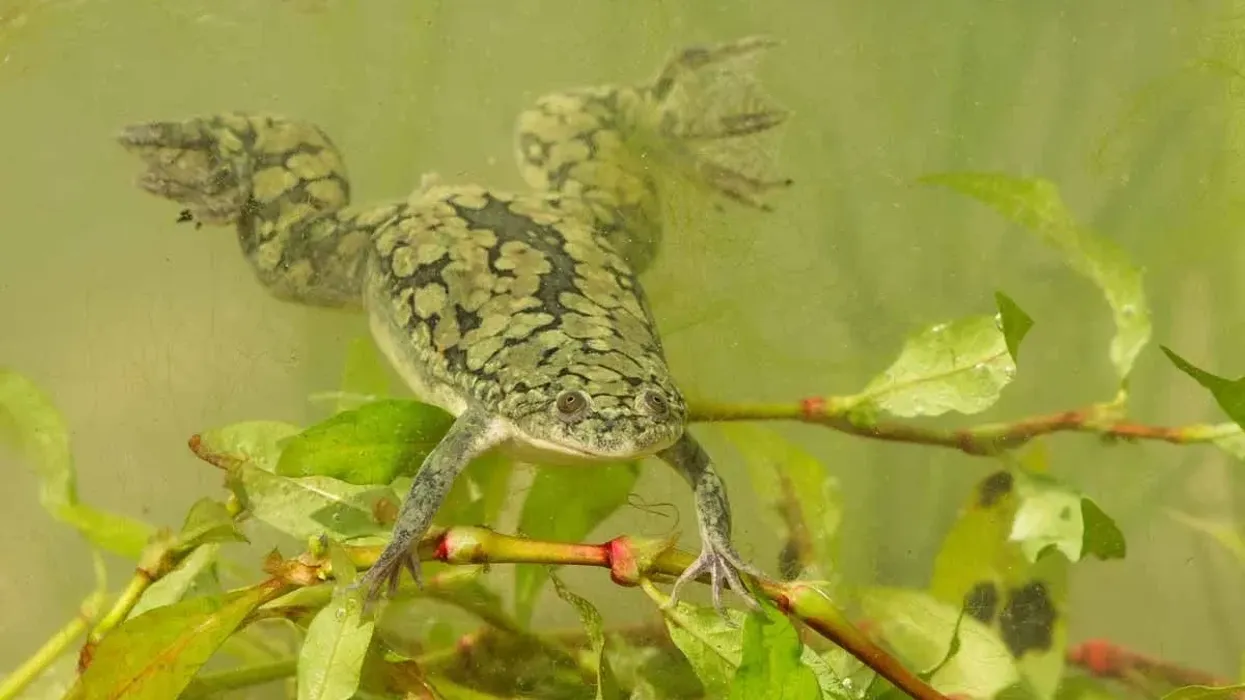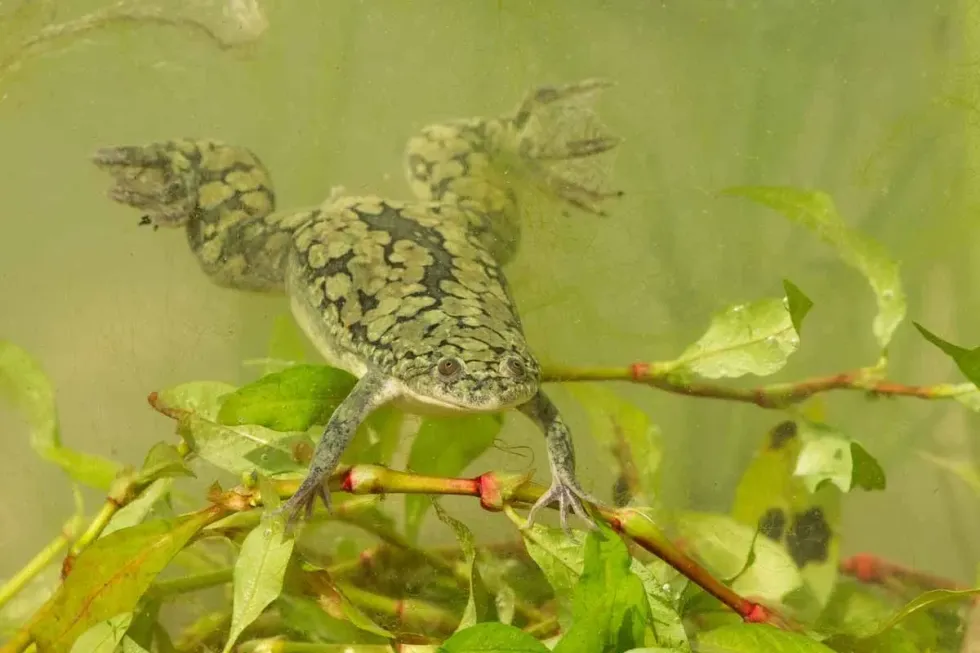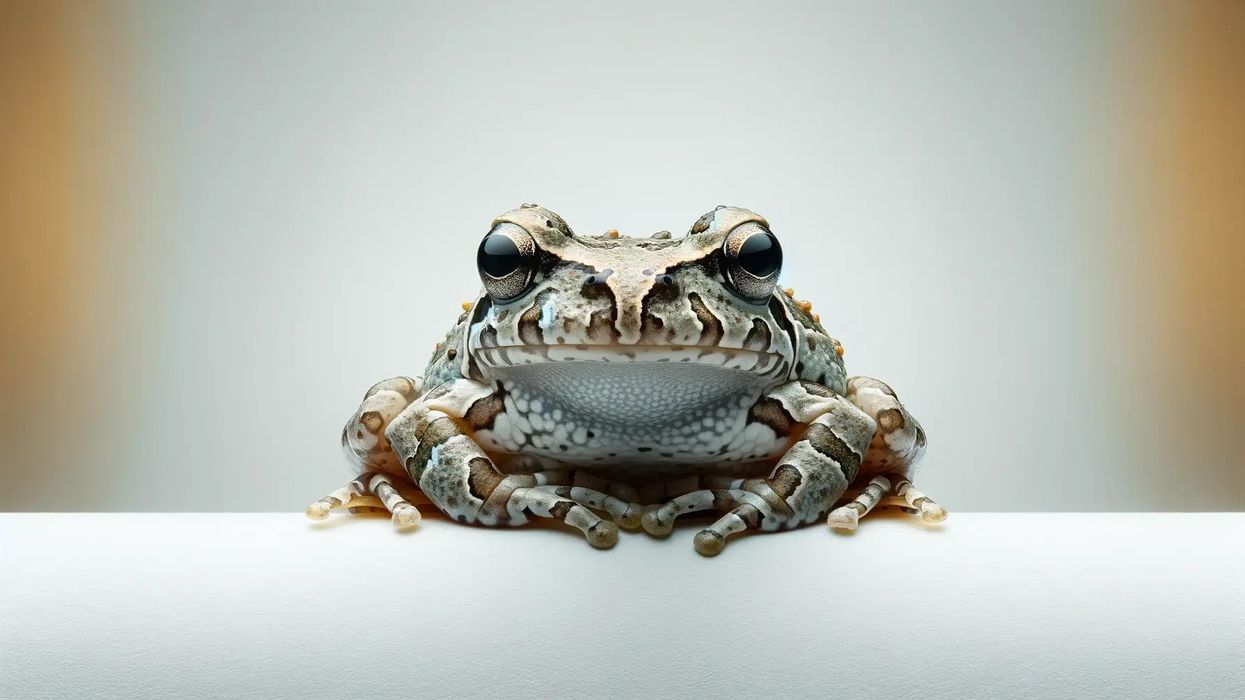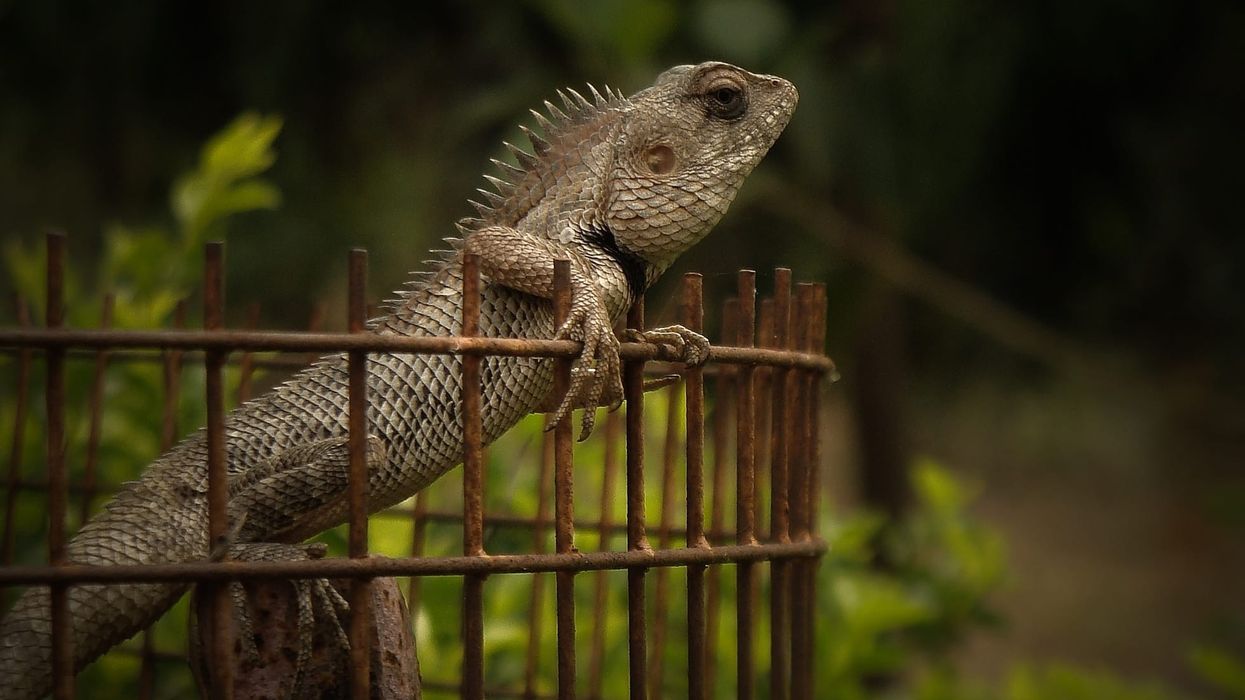The African clawed frog is an invasive species that is found native in the southern parts of Africa but has now relocated to places like Chile, California, and Great Britain. They were first found in Sub-Saharan Africa due to the sheer number of ponds and streams present there.
The clawed frog belongs to the family Pipidae and has a unique physique. Its hind feet are webbed while the front feet are not, but have claws that help them tear apart their prey.
This animal gets its name from its famous claws and its initial home the Sub Saharan Africa. Their skin color differs ranging from brown-grey to olive-grey or even albino.
African albino clawed frog is one type of clawed frog which is also native to Southern Africa. Their skin color might differ from the other but the albino African clawed frog facts remain the same.
These frogs have a rather unique breeding process. Breeding time can occur in any season but is common during the spring season.
The male and the female frogs reach sexual maturity at 10 to 12 months. The male frogs do not have any vocal sac but create mating sounds by contracting their laryngeal intrinsic muscles and producing alternate short and long trills.
The females get attracted to this call and respond with a rapping sound which is an acceptance call or a slow ticking sound which is the rejection call. This phenomenon usually takes place during the evening or at night.
These frogs are generally solitary creatures who live alone and sometimes come out to mate. But apart from that, they make very good pets and are kept in many homes and also in laboratories for experimentation. If you find this content interesting and informative then do check out the marine toad and the goliath frog.
African Clawed Frog Interesting Facts
What type of animal is an African Clawed Frog?
The African Clawed frog is a type of marine animal.
What class of animal does an African Clawed Frog belong to?
The African Clawed frog is an amphibian although they generally prefer the water and migrate to land only if forced to.
How many African Clawed Frogs are there in the world?
There is an abundance of African Clawed Frogs in the world. This is because they mate all throughout the year and lay hundreds of eggs at a time.
Where does the African Clawed Frog live?
African clawed frogs prefer grassland ponds and in some cases, streams of semi-arid and arid regions. They do not go into the land unless forced to and prefer staying in the water.
What is an African Clawed Frog's habitat?
African clawed frogs prefer stagnant, warm grassland ponds and in some cases streams of semi-arid and arid regions. They prefer these ponds and streams to be filled with green algae and be free of high plant vegetation.
They cannot tolerate any presence of metal ions in the water but can live in a high variation of ph. of the water body. It is an aquatic animal that generally stays in the water unless it is pushed to migrate.
Who do African Clawed Frogs live with?
African clawed frogs are solitary creatures. They prefer living on their own but comes out to mate. They can however be caught and kept as pets. The African clawed frogs were used to detect human pregnancy and even now are also used in certain experiments.
How long does an African Clawed Frog live?
African clawed frogs have an average lifespan of about 15 to 16 years if they live in their natural habitat. The oldest known African clawed frog lived up to the age of 20 but in captivity.
How do they reproduce?
African clawed frogs have no particular breeding season. Breeding time can occur in any season but is common during spring.
The male and the female frogs reach sexual maturity at 10 to 12 months. The male frogs do not have any vocal sac but create mating sounds by contracting their laryngeal intrinsic muscles and producing alternate short and long trills.
The females get attracted to this call and respond with a rapping sound which is an acceptance call or a slow ticking sound which is the rejection call. This phenomenon usually takes place during the evening or at night.
On the underside of his forward and paws, the male grows mating pads. Most frogs have axillary (front limb) amplexus while the mating embrace of these frogs is pelvic.
During the three to four hour act, the female releases hundreds of sticky eggs which are usually attached to plants or other anchors, one or more at a time. Tadpoles filter feed as they grow from the eggs.
During a span of 4 to 5 days, the tadpoles transform into small froglets with the tail absorbed into the body and maintaining its nutritional requirements. It takes about 6 to 8 weeks to go from egg to a small frog.
What is their conservation status?
There are plenty of African clawed frogs in the world thanks to their year-round mating season. However, they have become an invasive species after they were suddenly released into the wild after being held captive till the 1940s for use in detecting human pregnancy.
African Clawed Frog Fun Facts
What do African Clawed Frogs look like?

The African clawed frog looks different from regular frogs due to the absence of a visible ear and a tongue. The wedge-shaped head is smaller than its body which is flattened.
Its eyes are small, without eyelids, and situated on the top of its head.
While its large hind legs are webbed, the front feet are not webbed and slightly smaller in size. Its skin is a number of colors, ranging from grey to brown to olive-grey and its belly has a creamy white texture with a touch of yellow.
Unlike most male frogs, a male African clawed lack a vocal sac while the females have cloacal extensions.
How cute are they?
African clawed frogs are considered cute. With their small appearance and multi-colored bodies, they are often considered charming and are kept as pets.
How do they communicate?
African clawed frogs communicate with each other with the help of calls. Although the male frog lacks a vocal cord it produces sounds by contracting its throat which acts as a mating call to the female.
The female either accepts or rejects the call by producing a rapping sound or a ticking sound respectively. However, the male’s calls are rarely answered by the female.
How big is an African Clawed Frog?
African clawed frogs are not that big with a weight of about 0.13 lb to 0.44 lb ( 60 - 200g) and a length of 1.97in to 4.72in (5 - 12 cm).
How fast can an African Clawed Frog run?
The African clawed frog does not run; they swim in every direction up and down, backward and forward, at a speed of 5 mph and can sometimes be found crawling at a sluggish pace.
How much does an African Clawed Frog weigh?
An African Clawed Frog weighs about 0.13 lb to 0.44 lb ( 60 gm - 200 gm ).
The female is heavier than the male weighing about 0.44 lb or 200 gm while the males weigh about 0.13 lb or 60 gm.
What are their male and female names of the species?
The male counterpart is known as a male African clawed frog while the female counterpart is known as a female African clawed frog.
What would you call a baby African Clawed Frog?
A baby African clawed frog is known as a tadpole or a small froglet.
What do they eat?
African clawed frogs are carnivorous by nature. They can eat dead, dying, or living arthropods, organic wastes, but mainly stick to aquatic crustaceans, insects, marine and aquatic worms.
They exhibit scavenger-like behavior and will eat anything passing by it. It can locate food with the help of its intense sense of smell, hypersensitive fingers, and lateral line system. The line system helps it to understand the vibrations in the stream, and it sucks the food into the mouth with its hyobranchial pump.
The tadpoles and froglets are however filter feeders.
Are they dangerous?
African clawed frogs are not dangerous or aggressive to humans or bigger fishes or marine creatures. However, they are dangerous to their prey. These frogs exhibit a scavenger kind of behavior and eat anything that passes them. They can eat dead, living, or dying arthropods.
Would they make a good pet?
African clawed frogs do make good pets. They are kept for experiments in laboratories and as beloved pets all over the world for many years. They have a long life span and are extremely hardy which allows them to live up to a ripe old age of 20.
Did you know...
African clawed frogs have rather unusual behavior. They are rather lazy animals. They often lie still for almost a year. If the pond dries up during summer they will burrow themselves deeper into the mud. They prefer spending their time underwater and come up only to breathe.
The African Clawed Frogs birthing process
The mating process of an African clawed frog is very unique and its behavior is different from other frog species.
On the underside of his forward and paws, the male grows mating pads. Most frogs have axillary (front limb) amplexus while the mating embrace of these frogs is pelvic.
During the 3 to 4 hour case, the female releases hundreds of sticky eggs which are usually attached to plants or other anchors, one or more at a time. Tadpoles filter feed as they grow from the eggs.
During a span of four to five days, the tadpoles transform into small froglets with the tail absorbed into the body and maintaining its nutritional requirements. It takes about six to eight weeks to go from egg to a small frog.
Do people keep African Clawed Frogs?
People do keep African clawed frogs as pets as it is not illegal to own them. Although in US states it is illegal to own them without permission. Earlier these frogs used to be kept in captivity in order to determine human pregnancy. After the invention of better, safer methods, they were released into the wild.
Nowadays they are kept as pets in homes or for experimental purposes in laboratories. African clawed frog care is very easy.
People keep them in medium-sized aquariums with clean water. It is preferable to use gentle filtration cleaning processes as too much vibration can make them nervous. Also, there should be an ample amount of hiding space in the container for the African clawed frogs to feel safe.
It is also very easy to feed them with earthworms, bloodworms which are easily found in shops. They need food at least three or four times a week.
Here at Kidadl, we have carefully created lots of interesting family-friendly animal facts for everyone to discover! Learn more about some other amphibians including the pool frog and the caecilian.
You can even occupy yourself at home by drawing one of our african clawed frog coloring pages.









